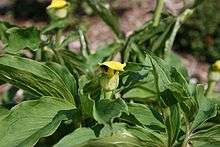Arisaema flavum
| Arisaema flavum | |
|---|---|
 | |
| Scientific classification | |
| Kingdom: | Plantae |
| (unranked): | Angiosperms |
| (unranked): | Monocots |
| Order: | Alismatales |
| Family: | Araceae |
| Subfamily: | Aroideae |
| Tribe: | Arisaemateae |
| Genus: | Arisaema |
| Species: | A. flavum |
| Binomial name | |
| Arisaema flavum (Forssk.) Schott | |
| Synonyms[1] | |
| |
Arisaema flavum (Konso litota or panshalla) is a species of flowering plant widespread across eastern Africa and southern Asia. It is native to Ethiopia, Somalia, the Arabian Peninsula, Pakistan, Afghanistan, Nepal, Assam, Himalayas, Tibet, Yunnan, and Sichuan.[1][2][3][4]
Description
The plant is 0.4 metres (1 ft 4 in)[5] with its tuber being subglobose and 1.5–2.5 centimetres (0.59–0.98 in) wide. Its petiole is either green or purplish in colour, is unmarked, and is 11–35 centimetres (4.3–13.8 in) long. The species' spathe is only 2.5–6 centimetres (0.98–2.36 in) while the spate tube is yellowish green, is ovoid, and is 1–1.5 centimetres (0.39–0.59 in) long by 1–1.4 centimetres (0.39–0.55 in) wide. The throat is dark purple and have oblong-ovate limb, which is also either yellow or green coloured. The limb is also accumulate, inside of which its dark purple in colour and is slightly incurved. The size of a limb is 1.5–4.5 centimetres (0.59–1.77 in) by 0.8–2 centimetres (0.31–0.79 in). It is bisexual and have an 1–2 centimetres (0.39–0.79 in) long spadix. Female basal part have ovaries and is greenish in colour. The male basal part is slightly different; it is lightly yellow coloured and is 3–7 centimetres (1.2–2.8 in) long by 2–3 millimetres (0.079–0.118 in) thick. The species' appendix is very short and is yellowish-green in colour. Flowers have 2 anthers which are 2-loculed.[6] The flowers blooming from June to July which are being pollinated by flies.[5] It berries are obovate the 3 seeds of which are pale yellow in colour and are 2–2.5 millimetres (0.079–0.098 in) long.[6]
Uses
It is a famine food, eaten during periods of crop failure or famine in the Konso special woreda, where it is endemic. It is preferred to other species of Arisaema due to its relatively acceptable taste, can be prepared within a short time, and is less perishable. But all varieties must be crushed and dried prior to further preparation. The dried parts are then ground to powder, which is mixed with water and cooked like maize for approximately 30 minutes.[7]
References
- 1 2 Kew World Checklist of Selected Plant Families
- ↑ Govaerts, R. & Frodin, D.G. (2002). World Checklist and Bibliography of Araceae (and Acoraceae): 1-560. The Board of Trustees of the Royal Botanic Gardens, Kew.
- ↑ Gusman, G. & Gusman, L. (2006). The Genus Arisaema. A monograph for botanists and nature lovers , ed. 2: 1-474. A.R.G. Gantner Verlag K.G., Ruggell.
- ↑ Mosti, S., Raffaelli, M. & Tardelli, M. (2012). Contributions to the flora of central-southern Dhofar (Sultanate of Oman). Webbia; Raccolta de Scritti Botanici 67: 65-91.
- 1 2 "Arisaema flavum". PFAF. Retrieved June 18, 2013.
- 1 2 "Arisaema flavum (Forrsskaol) Schott". Plants of Tibet. Retrieved June 18, 2013.
- ↑ Yves Guinand and Dechassa Lemessa (March 2000). "Wild-Food Plants in Southern Ethiopia: Reflections on the role of 'famine-foods' at a time of drought" (PDF). UN-OCHA Report. Archived from the original (PDF) on October 11, 2010. Retrieved January 15, 2009.